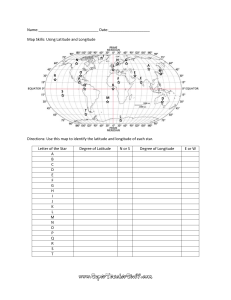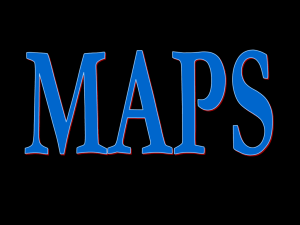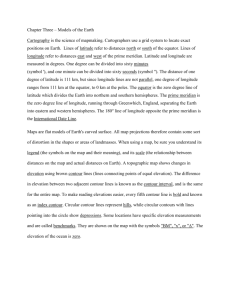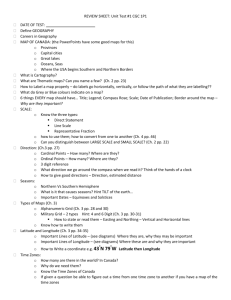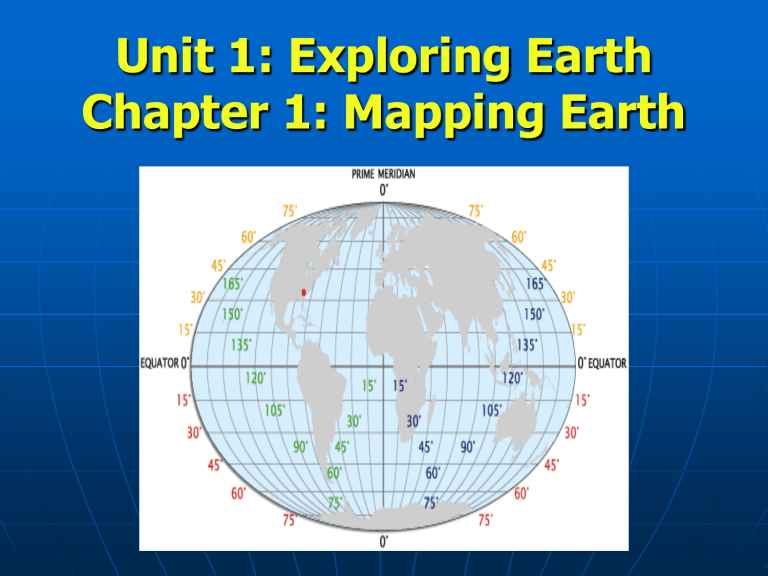
Unit 1: Exploring Earth Chapter 1: Mapping Earth Lesson 1: Maps I. Understanding Maps Maps are flat projections that come in many different forms Tues. Feb. 1, 2011 03:05:50 Wed. Feb. 2, 2011 03:05:50 Maps Most maps are drawn in map viewdrawn as if you were looking down on an area from above the Earth’s surface A profile view is a drawing that shows an object as though you were looking at it from the side. Each Map Contains: Legend: list of symbols and their meanings Scale: ratio between distances on a map and actual distances on Earth’s surface 1:25,000 - one unit on the map equals 25,000 units on Earth’s surface II. Reading a Map Latitude and Longitude How can I remember which lines are which? A. Latitude: distance in degrees NORTH and SOUTH of the EQUATOR (0°) Think of latitude like the rungs of a ladder (ladder sounds a lot like latitude). Latitude lines run east and west, but they tell how far up (north) you can go or how far down (south) you can go. Because lines of latitude never meet, they are also known as… Parallels: circles around the globe N or S of the Equator Each degree consists of 60 equal parts called minutes. Each minute is divided into 60 equal parts called seconds. D.C. is located at 38°53’51” North B. Longitude: distance EAST and WEST of the PRIME MERIDIAN (0°) When you think of longitude, think of long, tall telephone poles (because longitude lines run from pole to pole). Longitude lines run north and south, but they tell how far east you can go or how far west you can go. Because the Prime MERIDIAN is the main line of longitude, they are also known as… Meridians: semicircles running from pole to pole. As with latitude, there are minutes and seconds: D.C. is 77°0’33” West III. Plotting Locations Both latitude and longitude are needed to locate positions on Earth precisely. When giving coordinates, latitude is always given first. Do you know the coordinates of Staunton, VA? Latitude: 38° 8' 57" N 38 degrees, 8 minutes, 57 seconds North Longitude: 79° 4' 18" W 79 degrees, 4 minutes, 18 seconds West Distance • • • The distance on Earth's surface for each one degree of latitude or longitude = 69 miles (111 kilometers) The distance between lines of latitude remains constant. Why? What happens to the distance between lines of longitude as you move north or south of the Equator? Time Zones Earth is divided into 24 time zones Why 24? Earth takes about 24 hours to rotate once on its axis (360°) 360° ÷ 24 hours = 15° per hour Each time zone is 15° wide Each time zone represents a different hour International Date Line (IDL) 180° meridian gain or lose a day travel WEST across the IDL ► advance one calendar day (add 24 hours) travel EAST across the IDL ► move back one calendar day (subtract 24 hours) Why is the IDL crooked? IV. Map Projections Map projection: a flat map that represents a 3-dimensional globe Cartography: the science of map making 1. Cylindrical Projection: map shaped as a cylinder 2. Conic Projections: cone comes in contact with one parallel of latitude. Accurate along the parallel the cone is in contact with. * The most accurate projection Lesson 2: Technology and Mapping General Uses of Maps Physical Map- uses lines, shading, and colors to indicate features (mountains, lakes, streams) Relief Map- identify mountains and flay areas Political Map- show boundaries between countries, states, township Road Map- shows interstates, roads, expressways Types of Maps 1. Topographic Maps: maps that show topography (surface features and elevation changes) What are some surface features on Earth that you might find on a topographic map? • mountains • hills • valleys • rivers • forests • bridges • depressions Contour Lines: lines on a map that connect points of equal elevation. Contour Interval: the difference in value between adjacent contour lines on a map. Adjacent: next to adjoining abutting bordering Contour Rules: 1. Contours never cross or just stop 2. Contours never split 3. The closer they are to each other, the steeper the land 4. The further they are from each other the flatter the land 5. If a contour line shows a “V”, the point of the V points UP hill 6. A river will always flow in the opposite direction of the V’s point (DOWN hill) 7. When contours close in a circle, that represents a hill top Little ‘teeth’ (hachures) show depressions (holes) in the land Every point along a contour line represents the same elevation. This entire line represents 1200 feet above sea level. 11 50 12 12 50 00 Rules for Successful Contouring Rule #1 Can’t happen! 11 50 12 12 50 00 Contour lines NEVER split or divide! 11 50 Rules for Successful Contouring Rule #2 Rules for Successful Contouring Rule #3 11 50 12 12 50 00 Contour lines cannot just stop. They must either form a closed loop, or run off the edge of your map. 11 00 This is fine! ? What’s the elevation here??? ? What’s going on?? Is this area above or below 1200 feet? ? 11 50 12 12 50 00 Contour lines NEVER, EVER cross 11 00 Rules for Successful Contouring Rule #4 Tip 1: What does contour line spacing indicate? The closer together the contour lines are, the steeper the hill is. The more spread apart they are, the gentler the slope. Traveling along the red line would be much steeper than traveling along the green line. Tip 2: Which way is the stream flowing? When contour lines cross a stream or river, they form vshaped kinks in the lines that always point upstream. Also remember - Water always flows DOWNHILL! Blue Creek flow towards the East. Tip 3: Finding the hill tops Hill tops are easy to find. Just look for the concentric closed contour lines that form the top of a hill. Notice the contour lines that form the two peaks below. Tip 4: What do those funny hachure marks mean? 60 0 0 Some features, such as 80 the Grand Canyon, lakes, mines, or 0 0 7 sinkholes actually are holes in the ground. The hachured contours indicate a depression. Don’t confuse it with a Depression Contour Lines hilltop! 1. If you traveled from point A to point B, would you be going uphill or downhill? 2. What landform do you think this map depicts? a. Valley b. Mountain c. Plain 0 5 7 0 70 A B 0 80 X 825 50 0 60 0 70 0 80 0 3. In which direction does Maple Creek flow? a. Northeast b. Southwest c. Can’t tell from information given 4. What is the contour interval of this map? a. 50 b. 100 c. 400 le ap M ek e Cr D B 1150 6. Which hike would be steeper, from A to B or from C to D? C 1200 5. What is the approximate elevation at the top of this hill? a. 1240 b. 1300 c. 1000 A 1100 8. What type of landform is depicted here? a. a mountain b. a depression c. a valley 60 20 40 7. What is the contour interval of this map? a. 20 feet b. -20 feet c. 60 feet Topographic Profile The side-view of a surface feature 2. Geological Map Show the Geology of the mapped area. • geological formation – rocks with similar origin, age, and rock type. • geological cross section - profile view that shows a vertical slice through rocks below the surface. Map Technology 1. 2. Global Positioning System (GPS) satellites used for navigation Geographic Information System (GIS) – computerized information systems used to store and analyze map data • Database view - databases on winds, airplane flight, landing procedures, and airport layouts • Map view – set of interactive, digital maps that shows features and their relationship to Earth’s surface • Model view – run simulations under weather conditions 3. Remote Sensing – collecting information about areas without coming into physical contact (Landsat, OSTM/Jason-2 and Jason-3, and SeaBeam)
